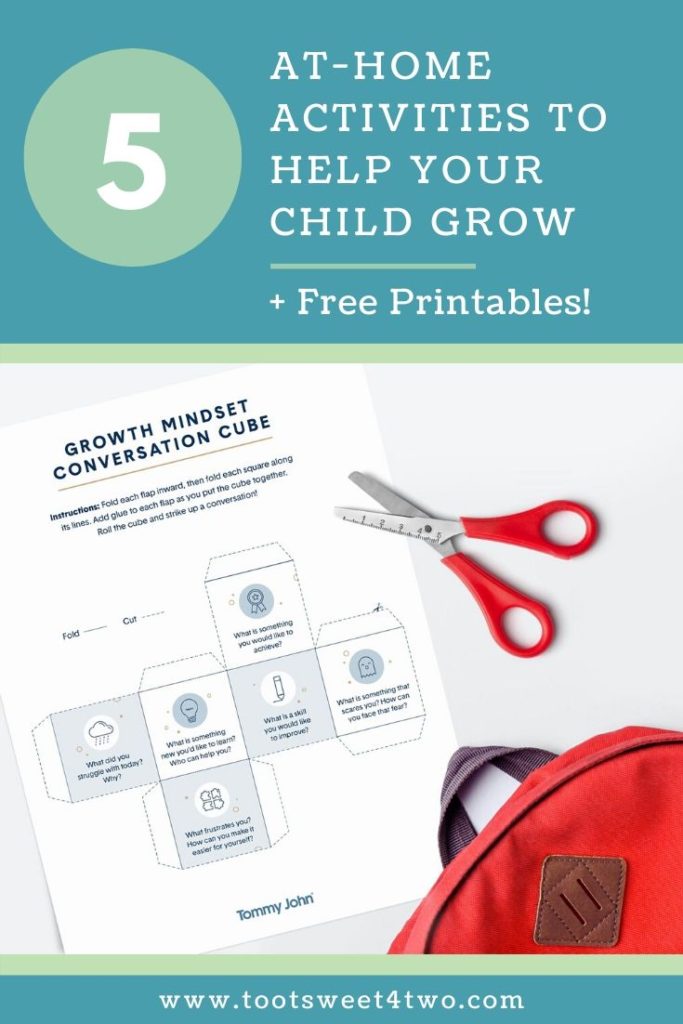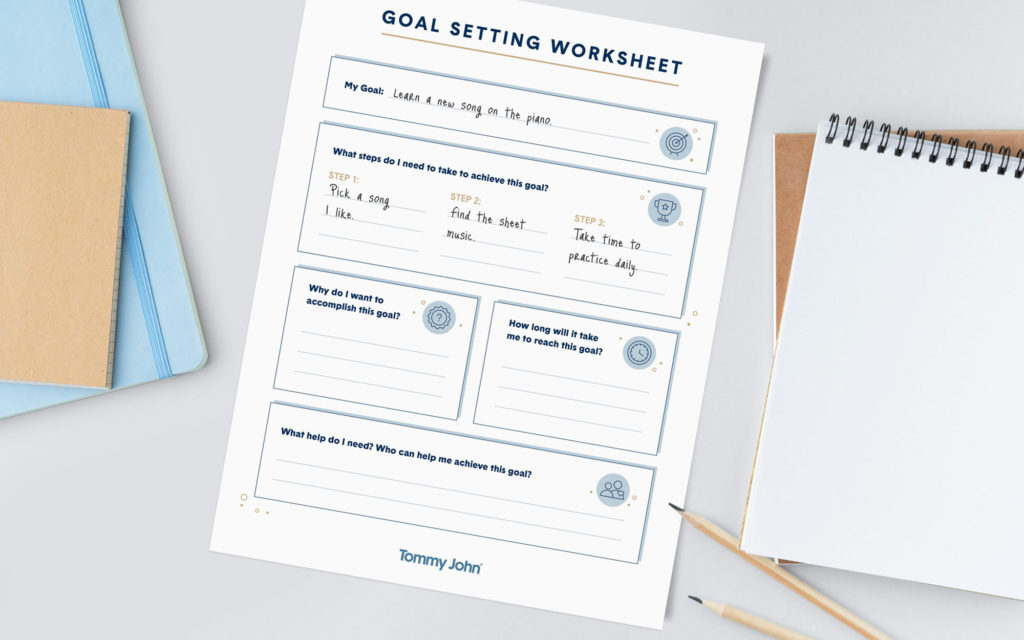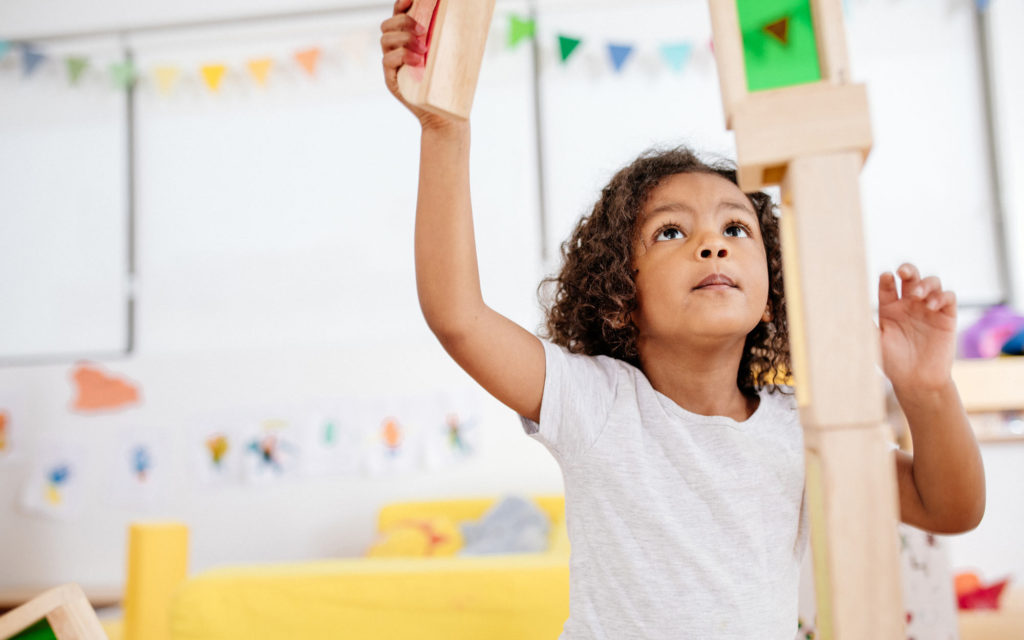
Due to current events, families are finding extra time on their hands where they need to entertain their little ones. However, with schools closed and extracurricular activities suspended, routine ideas just won’t cut it. To combat boredom, many parents are seeking out educational but fun activities to keep their children engaged while staying home. Popular ideas for at-home activities to help your child grow are watching animals at the zoo via virtual webcams, downloading e-books for reading practice, and listening to storytime from some of our favorite music artists and celebrities. But when it comes down to how much time our kids are spending on devices, we don’t always want to turn to a screen solution.
To help solve this issue, the folks at Tommy John have created a round-up of non-screen activities and printables geared to help kids develop a growth mindset. Living in the turbulent times that we are, they designed five science-backed exercises perfect for learning life’s teachable moments (even during unknown times) and make for great stay-at-home activities!
How to Set Your Kids Up for Success

Psychologist Carol Dweck’s book Mindset: The New Psychology of Success explores the concept of building a growth mindset in a world that is continuously changing with unpredictable challenges. Everything we do sets an example for our kids, from how we react and treat others to how we dress and invest in our self-care. However, preparing kids to be high achievers who lead happy, fulfilled lives is much easier said than done. Showing them how to persevere in the face of adversity is one of the best ways to help your children thrive. No one likes their kids to feel discouraged, but being challenged and experiencing failure are essential to allow them to grow.
Below we’ve outlined five at-home activities geared at helping teach your kids to be more self-aware, self-confident, and empathetic. The best part is that they’re easy to do in your home, whether it’s during breakfast as a break from school learning or right before bed as you cozy up in your pajamas. All of these activities can either be printed or created with paper at home! All you need is your little ones’ imagination, a few crayons for coloring, and easy to find supplies like scissors and jars for specific activities.
Keep reading for five perfect stay-at-home activities that will help your child grow during a crisis.
1. Emotion Grid Exercise

Sitting down and writing down your feelings is the best way for little ones to organize and understand their emotions. Collaborate with your kids and try an exercise where they can reflect on different times they’ve felt various negative and positive emotions. Talk through their experiences and invite them to share what made them upset or happy. Make sure to keep the conversation light-hearted and ensure your little one feels comfortable sharing.
This will help your child grow as they:
- Identify their emotions.
- Find appropriate ways to express and moderate their feelings.
2. Random Acts of Kindness Jar
Practicing kindness is more relevant than ever for the state of our society. Grab an unused mason or empty pickle jar and help your little one brainstorm kind acts that they can do from home. Simple ideas are sending someone a card or doing a family member’s chore. The most important part of this at-home activity is discussing why this person deserves kindness and how it will make them feel. Write down each act of kindness onto a piece of paper and put them in your jar. Pick out one random act of kindness to perform a day and select who this act of kindness will be for!
This will help your child grow as they:
- Understand other perspectives.
- Feel empathy.
3. Goal Setting Worksheet

Encourage your children to make time-sensitive goals with an action plan for a personal project they’re excited about. Teaching kids about setting “SMART goals” lays the foundation for helping them build a growth mindset. A “SMART” goal is used to help guide goal setting and stands for Specific, Measurable, Achievable, Realistic, and Timely. Therefore, a SMART goal incorporates all of these criteria to help focus their efforts and increase the chances of achieving that goal! Some ideas are cleaning up all the toys in their room three days in a row, reading twice a day for a week, or dressing themselves every morning on the weekends.
This will help your child grow as they:
- Feel capable and empowered.
- Understand the satisfaction of working towards something.
4. DIY Morning To-Do List
To do this at-home activity, grab a piece of construction paper or a whiteboard and place it somewhere that your family can access and see. Invite one person to be in charge of creating a morning routine that they will write on the board. Invite your whole family to participate in completing your morning to-do list and cheer each other on once you complete each task. Tasks can be making your bed, washing your hands, and picking up toys. When each task gets completed, invite the writer to check it off the to-do list. If your child is too young to write, then they can check off or cross out each task you write down. Emphasize the importance of keeping a list and how creating a routine can be beneficial.
This will help your child grow as they:
- Feel accountable and responsible.
- Feel like a leader.
5. Growth Mindset Conversation Cube

In the same way kids practice their multiplication tables or memorize vocabulary, simple written exercises can help them develop a growth mindset. Have kids create their own “conversation cube” with question prompts that spark conversation. Invite them to read their question out loud, pause, and consider their response and share for 20 to 30 seconds. This will encourage them to craft their answer and feel heard when it is their turn to speak.
This will help your child grow as they:
- Think critically and understand their feelings.
- Learn positive self-talk.
Any time your kid struggles with one of these tasks, resist the urge to help them right away. Instead, ask open-ended questions to help them come up with a solution on their own. For example, “I know you’re frustrated because [Problem], how can we find a way around it?” Active problem-solving builds resilience and creativity and lets them work through their feelings to come to a resolution constructively.

Another part of encouraging them to grow during this time of crisis is leading by example. Are you getting enough rest, finding time for exercise and wellness, and staying connected with loved ones? It’s so much easier for kids to mimic your positive behavior when you practice what you preach. Have a sense of humor and be easy on yourself in this time of constant change. Showing your kids that you are stressed doesn’t help them form a positive mindset. They know you’re not perfect, but allowing them to see that you’re trying your best is crucial to help them build a sense of resiliency.
While your kids may not be engaging with others at school or in social settings, that doesn’t mean they cannot use this time to grow themselves. Any of these at-home activities can help your child grow during this time of uncertainty, and we’ve included them below for you to download and print! These exercises can help your child spark conversation, reflect on emotions, and show empathy towards others, so encourage them to spend time on activities that will set them up for success.
 Guest Bio
Guest Bio
Stacy Walden is a writer from sunny San Diego who enjoys covering topics around holiday decor, entertainment, and travel. When she’s not writing, she enjoys spending time at coffee shops and exploring new parts of San Diego!
RELATED POSTS FROM TOOT SWEET 4 TWO’S ARCHIVES:
5 Ways to Unplug Your Family Room and Spend Quality Time Together on a Budget
Spending Quality Family Time in the Kitchen
A Rookie’s Guide to Grocery Shopping During a Pandemic
42 Pantry Foods to Stock for Emergencies

Leave a Reply